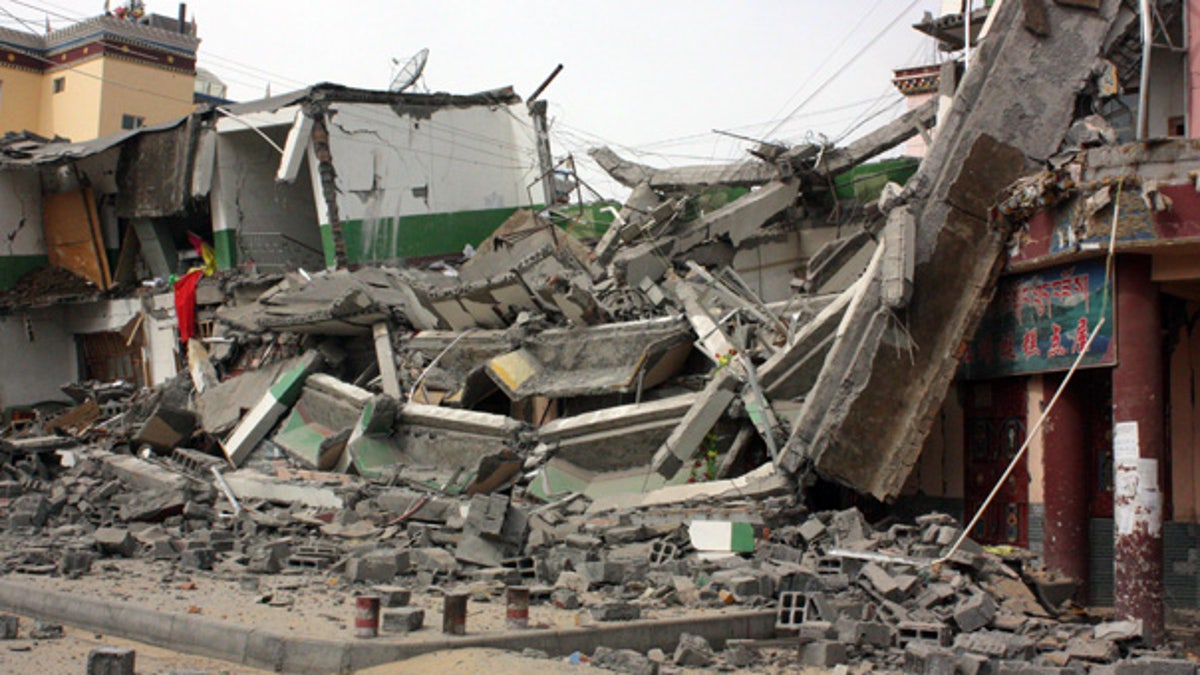
Apr. 14: A building is destroyed by the earthquake in Jiegu Town, western Qinghai Province, China. (Xinhua via AP)
MADOI, China – Rescue teams fought gusty winds and altitude sickness Thursday as survivors faced a second night outside in freezing weather after strong earthquakes left more than 600 dead and 9,000 hurt in a mountainous Tibetan area of western China.
Rescuers, tired from the high winds and thin oxygen, pulled survivors and more bodies from the pulverized remains of the town flattened by Wednesday morning's quake, the largest of which was magnitude 6.9. About 15,000 houses have collapsed.
"We've seen too many bodies and now they're trying to deal with them. The bodies are piled up like a hill. You can see bodies with broken arms and legs and it breaks your heart," said Dawa Cairen, a Tibetan who works for the Christian group the Amity Foundation and was helping in rescue efforts. "You can see a lot of blood. It's flowing like a river."
Xinhua reported that Premier Wen Jiabao arrived in Yushu to check on the rescue work and meet survivors.
Grim pictures emerged from several collapsed schools that were the focus of early rescue efforts. Footage on state television and photos posted online showed bodies laid out near the rubble, and the Xinhua News Agency quoted a local education official as saying 66 children and 10 teachers had died, mostly in three schools.
But as roads were cleared and the nearby airport put into operation, relief operations quickened with more than 10,000 soldiers, police, firefighters and medical workers now in Yushu county, where Jiegu is located, said Zou Ming, director of disaster relief with the Ministry of Civil Affairs.
It appeared China was turning down offers of help from foreign rescue teams. Zou said the affected area was limited. "So we do have enough rescue teams," he told a news conference in Beijing, adding the offers of help were appreciated.
Zou said that 617 died in the quake, with 313 missing and more than 9,100 hurt.
The influx of rescue workers was producing unintended effects, taxing the normally scarce resources of remote Yushu, where the altitude averages around 13,000 feet (4,000 meters).
Supplies of food, water, gas and other necessities were running low, said Pierre Deve, a program director at the Yushu-based community development organization Snowland Service Group. Deve said he waited for hours in a line of some 100 cars at the only open gas station. Most shops in Jiegu remained shut, he said, and local Buddhist monasteries handed out some food while some people scavenged food and other belongings from what was left of their houses.
Zou said tents, thick quilts, clothing and food were needed, adding that limited transportation options were slowing the delivery of aid to survivors. He said nearly 8,400 tents had arrived by Thursday afternoon, with plans underway to send about 40,000 tents, enough for 100,000 people.
That equals nearly the entire population of Yushu, where the Ministry of Civil Affairs said about 15,000 houses collapsed.
"There are enough tents. The main problem is the lack of transportation capabilities and it will still take time for all these tents to arrive," Zou said.
Another problem is the altitude, said Miao Chonggang, deputy director emergency response under the China Earthquake Administration.
"Lots of our rescue workers are suffering from different degrees of altitude sickness. The effectiveness and capabilities of the sniffer dogs have also been affected," he told the same news conference in Beijing.
Dozens of monks were either dead or missing at the Thrangu monastery, about 6 miles (10 kilometers) outside Jiegu, when all but its main hall collapsed, said Danzeng Qiujiang, a senior cleric at the Xiuma monastery far to the north of town.
"Only seven or eight of the monks are left alive. All the rest have gone missing. The rescuers either can't find them or found their bodies. I'm not sure how many deaths have been confirmed yet. But 60 of 70 of them have all gone missing," the cleric said.
Wednesday morning's quakes -- the worst of which measured magnitude 6.9 by the U.S. Geological Survey and 7.1 by China's earthquake administration -- were the worst to hit the region since the massive Sichuan earthquake two years ago left 90,000 dead or missing.
The destruction of schools was an eerie echo of the Sichuan quake, in which thousands of students died when their poorly built schools collapsed. But unlike in Sichuan -- where schools toppled as other buildings stood -- everything fell over in Yushu.
Xu Lai, a spokesman for the Qinghai-based educational NGO Gesanghua, said rescue crews focused on recovering children buried underneath the rubble at the Yushu No. 3 Primary School, which has more than 3,000 students.
"Most of the collapsed buildings were the first and third grade classrooms at Yushu No. 3 Primary School because they were fragile structures made from mud rather than brick and cement," Xu said.
"I am not sure how many bodies were pulled out and how many still remain. Communication with the area still remains difficult and we trying to find out what happened to some of the other schools," Xu said.
He said local workers are going to the homes of families to ask if they are missing children.
